
Bologna Centrale is the main railway station in Bologna, Italy. The station is situated at the northern edge of the city centre. It is located at the southern end of the Milan-Bologna high-speed line, which opened on 13 December 2008, and the northern end of three lines between Bologna and Florence: the original Bologna-Florence line through Porretta Terme and Pistoia; the Bologna–Florence Direttissima via Prato, which opened on 22 April 1934 and the Bologna-Florence high-speed line, which opened to traffic on 13 December 2009.
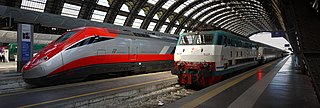
The Italian railway system is one of the most important parts of the infrastructure of Italy, with a total length of 24,567 km (15,265 mi) of which active lines are 16,832 km (10,459 mi). The network has recently grown with the construction of the new high-speed rail network. Italy is a member of the International Union of Railways (UIC). The UIC Country Code for Italy is 83.

Roma Tiburtina is the second largest railway station in Rome, after Roma Termini. Located in the north-eastern part of the city, it was originally constructed during the 1860s as a terminal station, and redeveloped during the 2010's. The station is connected to Rome's Metro line B at Tiburtina metro station, as well as to local bus services via an adjacent bus depot while private vehicle users are provided with more than 100,000 spaces across multiple on-site car parks.

The FL lines, formerly Lazio regional railways consist of 8 commuter rail lines operated by Trenitalia, converging on the city of Rome. It operates as a combined suburban railway system that connects the city-centre and the outskirts of the city via a commuter rail line.
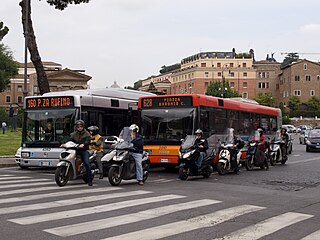
Rome has an extensive internal transport system and is one of the most important road, rail and air hubs in Italy.
Pescara Centrale railway station, also known as Pescara railway station, is the main railway station of Pescara. The station lies on the Adriatic line from Rimini to Lecce and the trans-Apennine line to Rome. It serves an average of 3.5 million people per year and is a 5-minute walk to the city's main street and to the beach.

Chieti railway station serves the city and comune of Chieti, in the region of Abruzzo, southern Italy. Opened in 1873, it forms part of the Rome–Sulmona–Pescara railway.

The FL1 is a regional rail route forming part of the Lazio regional railways network, which is operated by Trenitalia, and converges on the city of Rome, Italy.
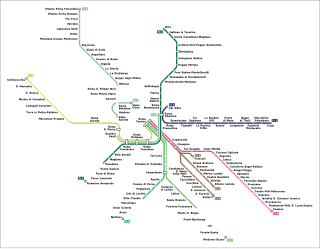
The FL5 is a regional rail route. It forms part of the network of the Lazio regional railways, which is operated by Trenitalia, and converges on the city of Rome, Italy.
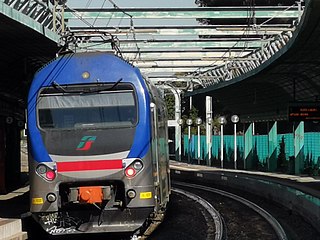
The FL3 is a commuter rail route. It forms part of the network of the Lazio regional railways, which is operated by Trenitalia, and converges on the city of Rome, Italy.

The FL7 is a regional rail route. It forms part of the network of the Lazio regional railways, which is operated by Trenitalia, and converges on the city of Rome, Italy.

The FL8 is a regional rail route. It forms part of the network of the Lazio regional railways, which is operated by Trenitalia, and converges on the city of Rome, Italy.
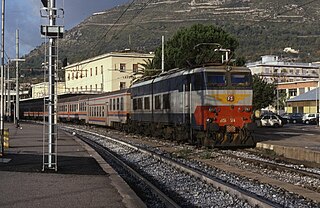
The FL6 is a regional rail route. It forms part of the network of the Lazio regional railways, which is operated by Trenitalia, and converges on the city of Rome, Italy.

The FL4 is a regional rail route. It forms part of the network of the Lazio regional railways, which is operated by Trenitalia, and converges on the city of Rome, Italy.
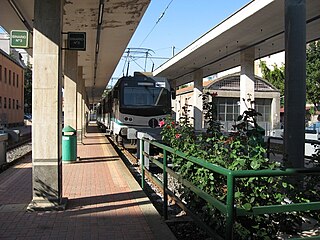
The Rome–Civita Castellana–Viterbo railway is a regional railway line connecting Rome, Italy, with Viterbo, capital city of the Province of Viterbo. The 102 km (63 mi) long line, also known in Rome as the Roma Nord line, after its former concessionaire, is part of Rome's metropolitan and regional railway network.

ATAC S.p.A. is an Italian publicly owned company running most of the local public transportation services, paid parking and incentive parking lots in Rome. More specifically, the company handles, on behalf of Roma Capitale Authority, the entire tramway, trolleybus network and metro lines, as well as most of the bus lines in the city. It also operates, on behalf of the Administrative Region of Lazio, three railways: Roma-Civita Castellana-Viterbo, Roma-Giardinetti and Roma-Lido. ATAC S.p.A., with its 2,200-kilometer-wide public transport network, its over 8,500 busses and 70,000 parking stalls, is currently one of the biggest public transportation companies in Europe and the largest in Italy.

Pescara Porta Nuova is a railway station in Pescara, Italy. The station opened in 1883 and is located on the Adriatic railway and Rome–Sulmona–Pescara railway. The train services are operated by Trenitalia.

Sulmona is a railway station in Sulmona, Italy. The station opened in 1888 and is located on the Rome–Sulmona–Pescara railway, Terni–Sulmona railway and Sulmona-Isernia railway. The train services are operated by Trenitalia.

Avezzano is a railway station in Avezzano, Italy. It opened in 1888 and is located on the Rome–Sulmona–Pescara railway and Avezzano-Roccasecca railway. The train services are operated by Trenitalia.

The Terni–Sulmona railway is a regional railway line in central Italy, managed by Rete Ferroviaria Italiana. It links three regions, Umbria, Lazio and Abruzzo, and three provincial capitals: Terni, Rieti and L'Aquila. Together with the Sulmona–Isernia railway it forms a north–south corridor through the Apennines in central Italy. Its route is the result of two unfinished railways that had to meet in Rieti: the Pescara–L'Aquila–Rome line, and the Terni–Avezzano–Roccasecca line.



















